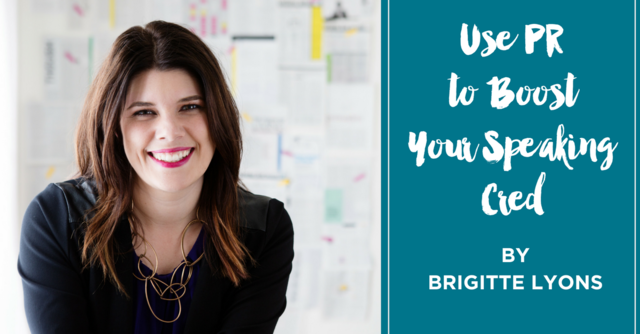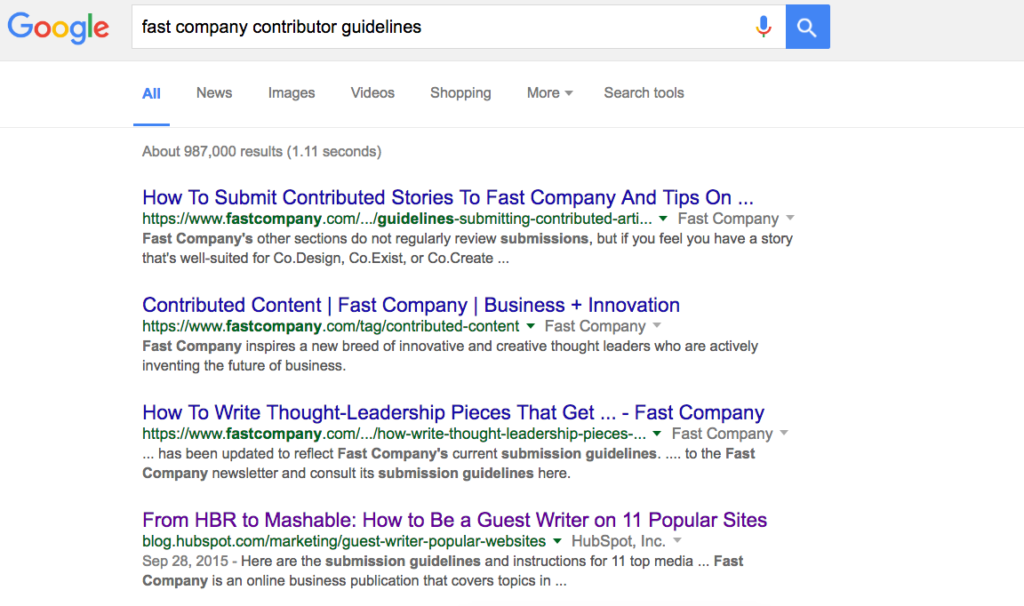Make Marketing Suck Less
How to Use PR to Boost Your Speaking Cred
By Michelle Mazur > October 25, 2016
Filed Under Relationship Building
 Brigitte Lyons is the founder of B, a boutique marketing and PR agency that helps thought leaders and small businesses hone their message and reach more of the right audience.
Brigitte Lyons is the founder of B, a boutique marketing and PR agency that helps thought leaders and small businesses hone their message and reach more of the right audience.
Booking high paying gigs is the dream of every speaker, but the path from occasional panelist to rockstar keynote can be full of fits and starts.
You already know that creating your signature talk is the first step, but what if you’ve nailed your message and delivered the speech and the gigs still aren’t coming?
It may be time to raise your profile.
I’ve worked on both sides of the equation, as a PR pro helping clients book speaking events and as a conference organizer booking $50,000 keynote speakers. And what I can tell you is this:
Event organizers have one main priority when they book speakers, and that’s attracting paying attendees to their event.
A big part of your objective in positioning yourself as a sought-after speaker is demonstrating to these organizers that you’ll help them draw an audience.
Think of it from the organizer’s perspective. A speaker who’s gotten publicity in a mainstream business magazine like Entrepreneur or wellness outlet like Real Simple is more likely to draw a crowd. You’ve already demonstrated that your ideas are attractive to the gatekeepers of the press, and your presence accompanied by those media endorsements adds prestige to the event.
In other words, getting some media coverage can elevate your speaker profile in a powerful way. Once you’ve gotten coverage, you can mention the stories in your pitch, add media logos to your speaker page and share them on your home page as social proof.
Having a great speech is non-negotiable, but PR can be that extra sizzle that sways their decision your way.
And the best news is that publicity is free and available to any thought leader that goes after it!
I have a long track record of helping coaches, consultants and other thought leaders get media coverage in prestige outlets like Fast Company, Entrepreneur, Inc and more. And today I’m here to share with you a simple guide on how to get your own publicity, so you can elevate your speaker profile.
Table of Contents
- 1 Step 1: Identify the media niche that makes sense for your audience.
- 2 Step 2: Look for contribution opportunities.
- 3 Step 3: Come up with your contribution topic.
- 4 Step 4: If the requirements call for it, write the article.
- 5 Step 5: Share your idea with the media outlet.
- 6 Step 6: Move on to your next submission!
Step 1: Identify the media niche that makes sense for your audience.
Ideally, you’ve already identified who you want to be speaking for. These event organizers are the audience you want to impress with your PR. So when you’re identifying media to pitch, you want to look for the media outlets that are most likely to wow the organizers you’re reaching out to.
For example, a business leader or expert may want to consider media like Fast Company, Entrepreneur, Business Insider or the Wall Street Journal.
For events that are consumer-oriented, you should look to the media that prevails in your space. If you’re speaking to parenting bloggers, think of Parents magazine, Working Mother, Mom.me and similar sites.
One of my favorite resources for finding influential media in any industry is Alltop.com. You can search for trending stories (and media outlets) in just about any topic or industry you can imagine!
Step 2: Look for contribution opportunities.
When you’re getting started with PR, contributions are the fastest and easiest way to break in. Once you’ve identified a few sites that are a good match for your speaking topic, search for “[site name] contributor guidelines.”
With the results, you’ll both confirm whether a site accepts guest contributions and find out how they want you to submit content.
Not only did I find out how to contribute to Fast Company, but I also see a Mashable article that lists some other opportunities. You can earmark these opportunities to approach as well!
As you go forward, you’ll want to work on one media outlet at a time. It’s important that you don’t submit the exact same article topic to two outlets, so it’s best to have a goal to pitch 3-5 of these, but you’ll want to approach them one-by-one from here on out.
Step 3: Come up with your contribution topic.
Developing an article angle for the press is a lot like crafting your signature talk. The key is offering up a new twist on one of the topics the media outlet covers all the time.
You should already be looking at media that covers your topic, so this won’t be too challenging. All you need to do is take a look at the headlines on the site, and find a place where you feel the advice is incomplete, or worse, on the wrong track entirely.
Your contribution topic should always be proposed with a headline. So write your own challenging the status quo.
Some of the best contributions have headlines like:
- The Top 3 Misconceptions About [Your Topic]
- Why Everything You’ve Learned About [Your Topic] Is Wrong
- 5 Unconventional Hacks for [Topic]
Let’s say your topic is about work-life balance, and you’ve decided to pitch Working Mother. You might propose a story on, “How The Drive for Work-Life Balance is Stressing Moms Out.”
If you’re not comfortable going for the negative angle, you can also use this as an opportunity to rave about a solution the media hasn’t covered yet. A headline using this tactic might look like, “The Surprising Work-Life Balance Solution That Can Save Your Downtime.”
Step 4: If the requirements call for it, write the article.
Some media outlets require you to submit a completed article. If that’s the case, you’ll want to write one, paying close attention to any word-length or other writing guidelines.
If not, skip ahead to step 5.
Step 5: Share your idea with the media outlet.
Once you have your topic and draft ready (if required), it’s time to email it to the media outlet. Most sites have either an assigned email address or contact form for submissions, and in my experience, those are closely monitored.
Always follow directions they give you. Often the media outlet will tell you exactly what they want to see in a submission.
Step 6: Move on to your next submission!
Now that you’ve got your first submission out, it should be much faster to prep your second, and third!
PR can be a numbers game, so it’s important not to just send out one article idea and hope it comes through.
It’s a lot like pitching yourself as a speaker. You may not get a lot of replies back, but the ones that do go your way are gold!
Get more PR and marketing tips from Brigitte by signing up for her weekly emails at bthinkforward.com/remix.
Create Your One-of-a-Kind Message
Your 3 Word Rebellion is the Key to Growing Your Business & Impact







